How FAQs Affect SEO and Best Practices for Optimizing Your FAQ Page
Topic: SEO
Published:
Written by: Bernard Huang
How does search engine optimization (SEO) for FAQ pages work? How do you structure the page to reach customers searching for your target keywords? And what questions should you add?
It’s time for an FAQ on FAQs.
In this guide, you’ll learn what an FAQ page is and whether you should opt for a dedicated page or incorporate a section on an existing page. We’ll also go over the best FAQ SEO practices to follow and how to build them using this information.
What is an FAQ page?
An FAQ page is a collection of frequently asked questions related to your brand as a whole or covering a specific topic.
You can create a standalone page, similar to a knowledge base. A knowledge base is a centralized library of information, often including more visuals and instructions than an FAQ.
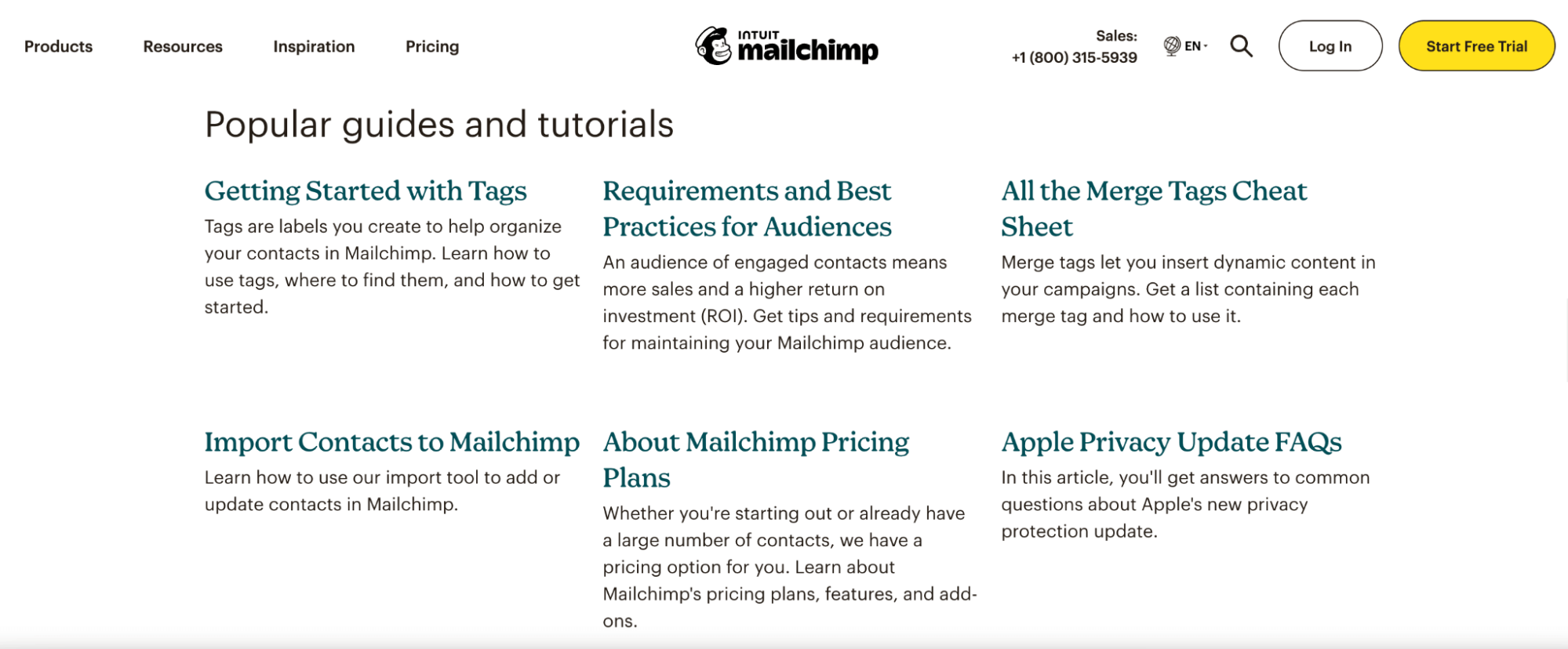
Mailchimp has a comprehensive knowledge base with walkthroughs and how-tos in addition to FAQ (image source).
This example from Mailchimp shows some of the information you might include in a knowledge center, including FAQs.
You can also add short FAQ sections to existing pages, like your homepage or product pages. You can also include them in places like customer emails and order confirmations.
You’ll find many different questions and answers on an FAQ page, but they often address common topics, such as:
Features included in a product or service
Product or service pricing
Definitions
FAQ content can involve a lot of variety, from how long the pages are to how you organize questions.
You can use FAQs as part of your content marketing strategy with the aim of creating relevant internal linking opportunities or generating organic traffic with the content.
Next, we’ll look at the two main types of FAQ pages: on-page and dedicated.
On-page FAQ
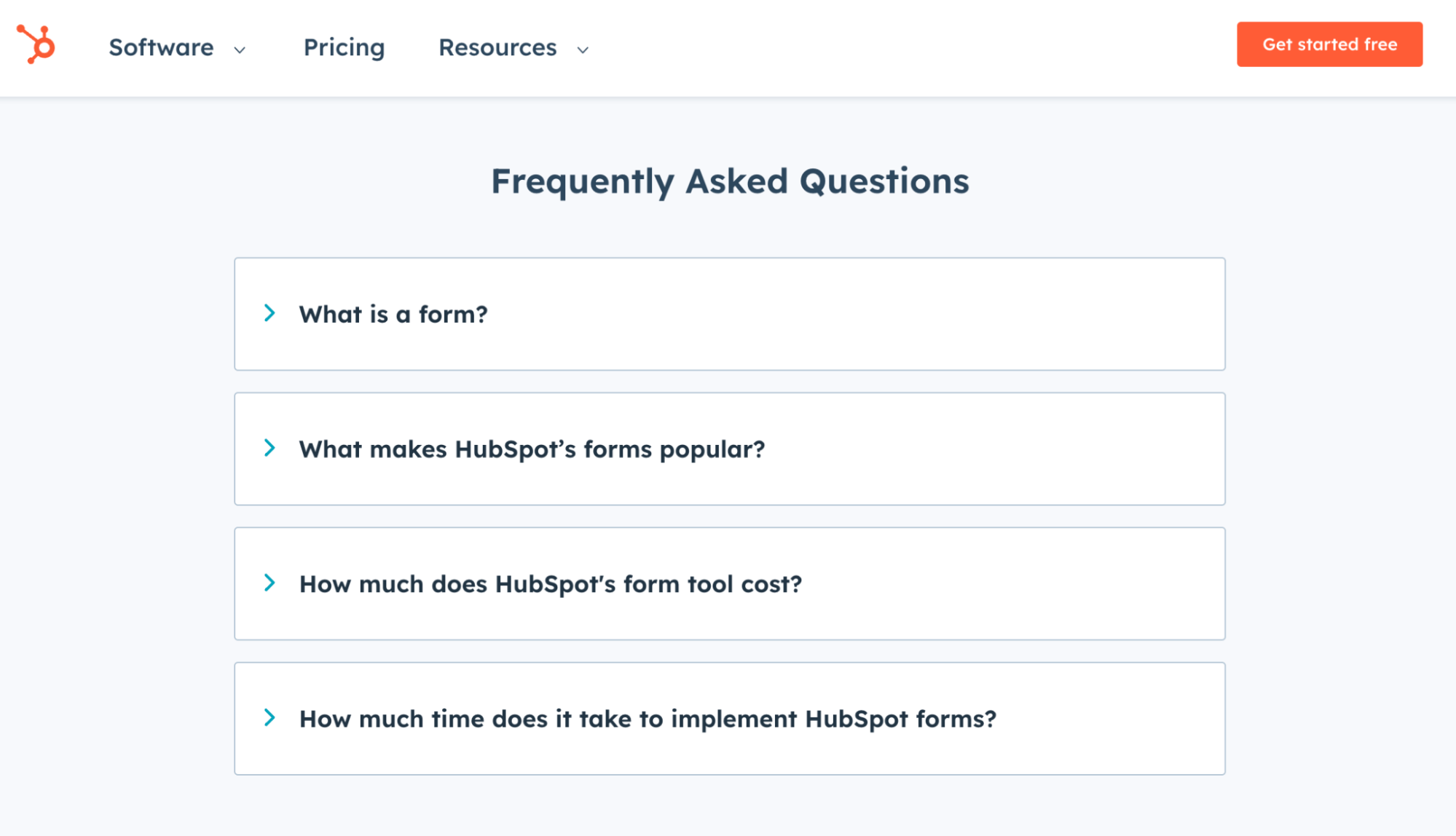
HubSpot adds a small FAQ section to almost all of its product pages (image source).
For example, HubSpot adds FAQ sections to almost every product page on its website. The company uses this section to answer common questions a potential user might have, such as how much the service costs and what features they can expect to find in the software.
This is a great section to add to a landing page, as well. You can boost your word count and hit common relevant keywords for a topic in a way that is directly related to what your reader is searching for.
You can further break down on-page FAQs into homepage, product page, and blog post FAQs, which we'll go into more detail below.
Dedicated FAQ page

Adobe has a well-built and to-the-point FAQ page with tons of internal linking and good organization (image source).
Dedicated FAQ pages are often large collections of information on a variety of subjects. Ideally, they’re organized into an easy-to-navigate section of a website.
Usually, when people think about FAQ SEO, they're trying to figure out how to optimize a dedicated page.
Adobe has a very clean design that works well for its dedicated FAQ. The brand splits up questions by category, making it easy for customers to find the right page for the product they have questions about
Many of the questions lead to other pages that have more detailed answers, but the central FAQ page acts as a directory, keeping everything organized.
How to create a compelling FAQ page
There are a few aspects to think about when crafting your FAQ pages. You need to decide what format to go with, come up with the questions you’ll answer, and consider how you’ll organize them.
Here are some tips on how to do that:
Decide the type of FAQ page to create
Homepage FAQs: This is a section on your homepage, usually toward the footer, that answers a few common questions. You don’t always need one, but it can help fill out sparse homepages.
The main thing to keep in mind with homepage FAQs is that they should be brief. You don’t want to add dozens of questions to them. That risks making your homepage cluttered and visually unappealing.
Instead, try to address a few of the most common questions, like price, main features, or use cases. Add a call to action (CTA) at the end that will direct readers to your dedicated FAQ or service page.
Dedicated FAQs: These tend to be the longest FAQs. They're great for organizing all of your questions in one spot. They also help with internal link-building since you can link each question to related pages and posts. In addition, a dedicated page can act as part of your knowledge base.
One of the trickier parts of a dedicated FAQ is deciding how to organize it. For example, you may initially break it down by product type, only to find yourself repeating many answers.
We’ll go into this in more detail later, but having questions arranged by subject or product is a good start.
Service or product page FAQs: Placing a few important questions at the bottom of your product or service pages is another great way to boost FAQSEO and proactively address any concerns or objections a potential customer may have.
You can help customers make decisions by providing information about pricing and showing the most popular features of your product or service.
Blog post FAQs: You may also opt to build entire blog posts on different questions. This is especially useful for high-traffic queries.
Note that not every question works well as a blog post. These work best with questions that are more nuanced than “How much does your service cost?” Instead, focus on topics that could have multiple answers or may have different interpretations.
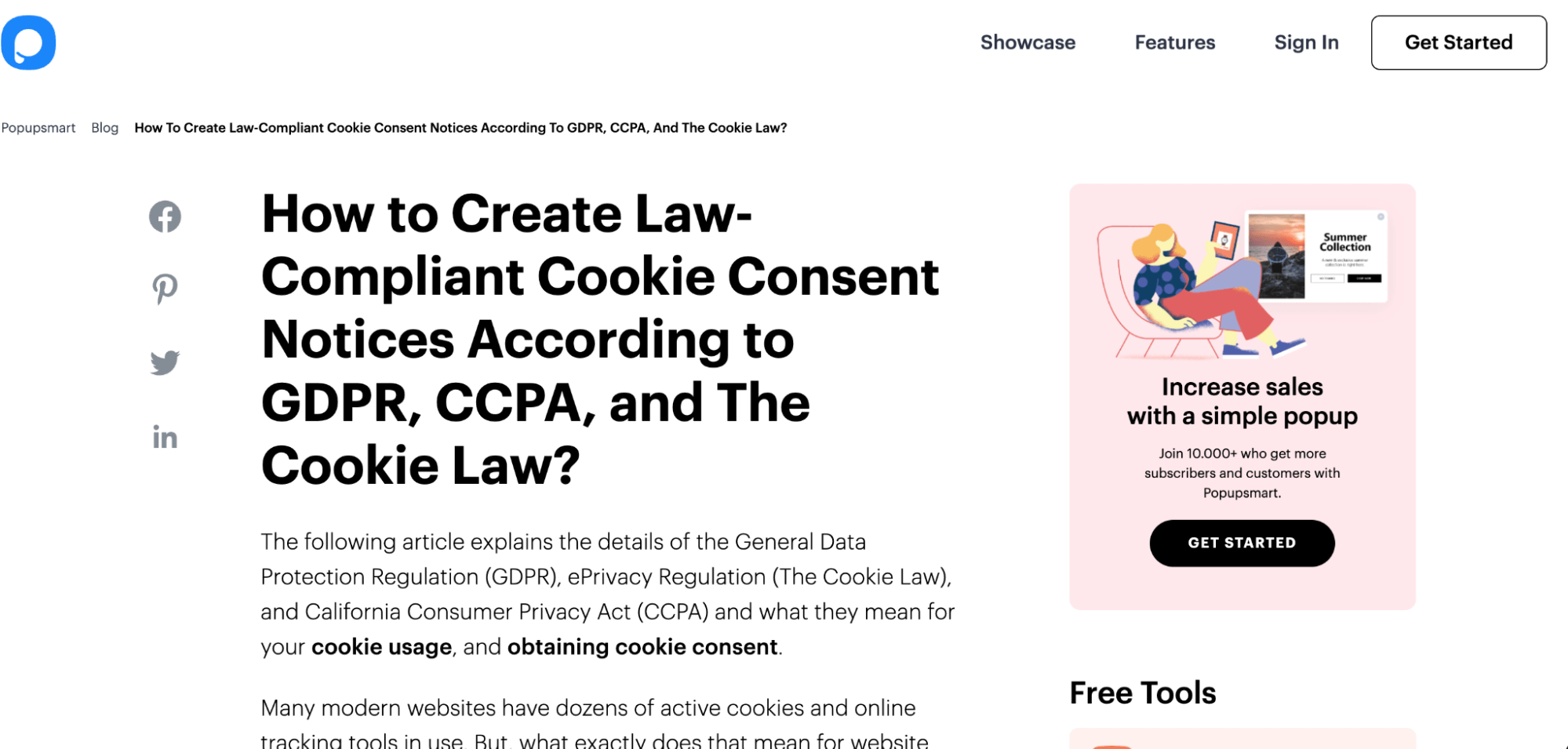
Blog post FAQs should delve into specifics, not general questions (image source).
Take this example from Popupsmart. The software-as-a-service (SaaS) company has a very detailed post about cookies and how laws governing privacy might affect a website’s use of them. It addresses questions a potential customer may have and helps them navigate the often tricky internet data protection regulations.
These types of posts also work well with FAQ schema, a markup you add to your page so Google can present the information as a rich snippet. We’ll go into more detail about this concept below.
Where to find questions to add to your FAQ page
You may already have some great questions from customers, but you might still need to supplement your FAQ page
Here are some helpful ways to find high-quality questions online:
Keyword research
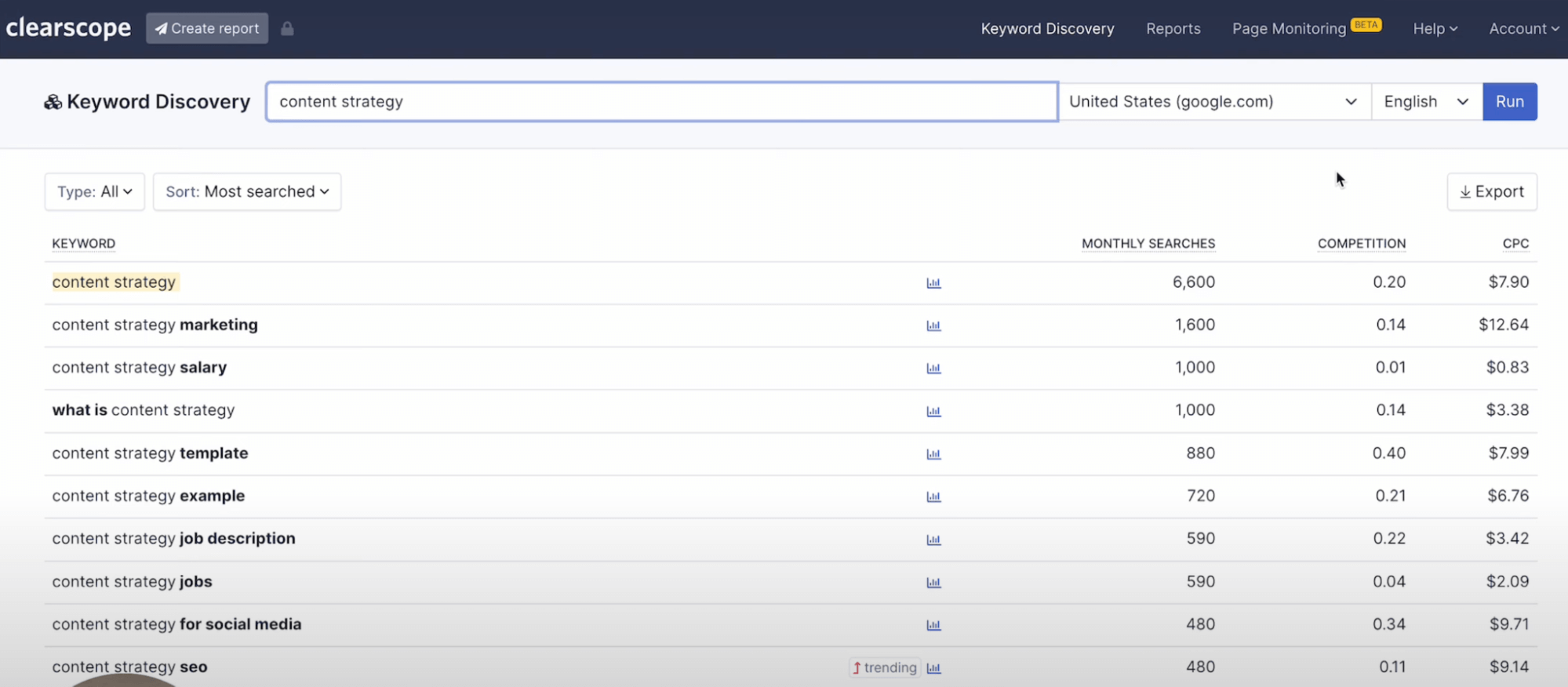
Optimize your FAQ with good keyword research to make sure there’s an audience for your topic (image source). This is from 0:53 on the video.
When doing keyword research for articles, you’ll probably come across some similar keywords to those you end up using. You can potentially use these additional keywords as questions for your FAQ. You’ll also be able to understand what else your audience is curious about regarding your chosen topic.
In general, keyword research can help you word questions in a way that will reach your audience by understanding the language they use to talk about the subject.
People also ask (Google)

Screenshot
A People also ask section appears with the Google Search results for about 40-70% of queries. This section provides related questions to Google searches that real users are asking, helping you determine their intent and generate more ideas.
Online forums, social media, and groups

Screenshot
Forums and websites like Reddit and Quora thrive on user-generated questions. You can search forums or subreddits dedicated to your subject matter.
Other great places for certain niches are Facebook groups or Twitter.
Remember, the best forum for your website will vary depending on your niche and audience. Even platforms like Pinterest or Instagram can be helpful for certain topics.
Clearscope Drafts
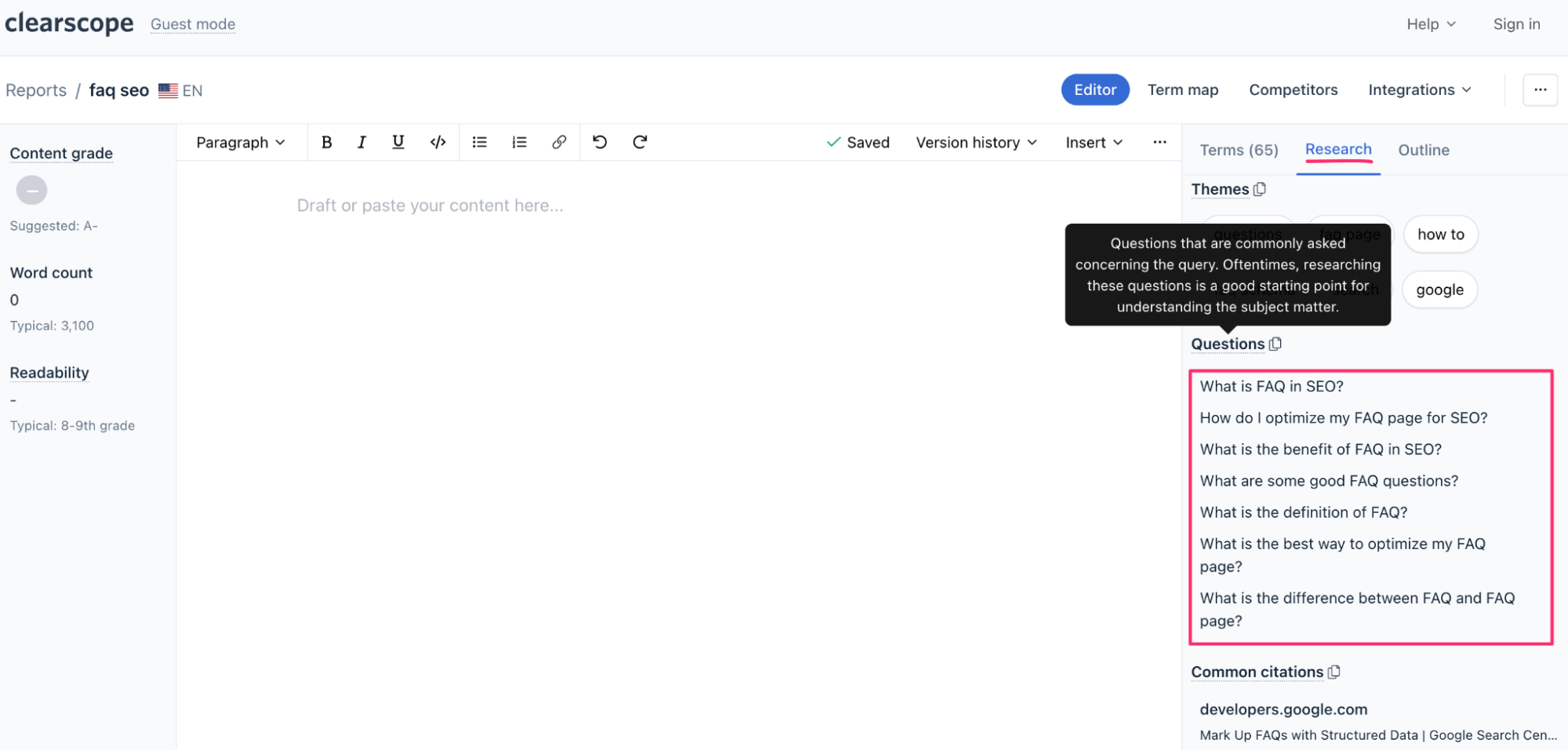
Screenshot
Clearscope Drafts can also help you come up with FAQs. On the right side of the draft, you’ll find the Research tab. By clicking this, you’ll find even more questions related to the topic, along with recommendations for where to look next.
You can also use the topical exploration tab and filter to only questions. This will also show you the search volume for these search queries.
Keep your FAQs organized
Before we get into the nitty-gritty of FAQ SEO, it’s important to remember that some parts of SEO are generally helpful for user experience — like how to organize information.
When Clutch surveyed users about their website preferences, 94% said an easy-to-navigate website was the most important feature they looked for. One way to help with that organization is with structured data. Google uses structured data with specific markup to better understand search results (more on this later).
When your pages are easy to understand and navigate for both users and robots, that’s when you hit the sweet spot in FAQ SEO.
A good way to organize your FAQ is by topic. Instead of including every subject on one page, break down the questions into a few different categories, such as:
Pricing
How-tos
General questions
Include a web of links — internal links connecting each page to the others — to avoid orphan pages (pages that don’t have links going to them). Chances are good that customers may think of new questions when researching a topic, so link to related articles as they come up.
But don’t try to answer every question in every section. If you’re writing an FAQ on pricing, answer questions about features on a different page.
If you try to stuff in unrelated questions, it’s harder for readers to find the answer they’re looking for. In addition, if you try to cover too many disparate topics on one page, it might be difficult for search engine algorithms to understand the user intent of that page.
Are FAQ pages good for SEO?
FAQ pages can be great for SEO rankings. Users generally like short, easy-to-read answers, and FAQs can provide those. They're also a natural place to work in relevant keywords on a given topic.
When you write an FAQ with the intent to answer your readers’ questions, you’re providing high-quality information that search engines like Google prioritize. As we’ll discuss in more detail later, you can even add specific formatting to your FAQ to help Google better understand it.
FAQs can be helpful for reaching potential customers at the beginning of their journey when they are still doing research on the subject.
Just be careful to avoid creating low-quality pages that don’t fully answer questions or are simply stuffed full of keywords, as those won’t help your content optimization strategy. Most of the time, FAQ SEO generally follows similar practices to your on-page SEO content.
Best practices for FAQ SEO
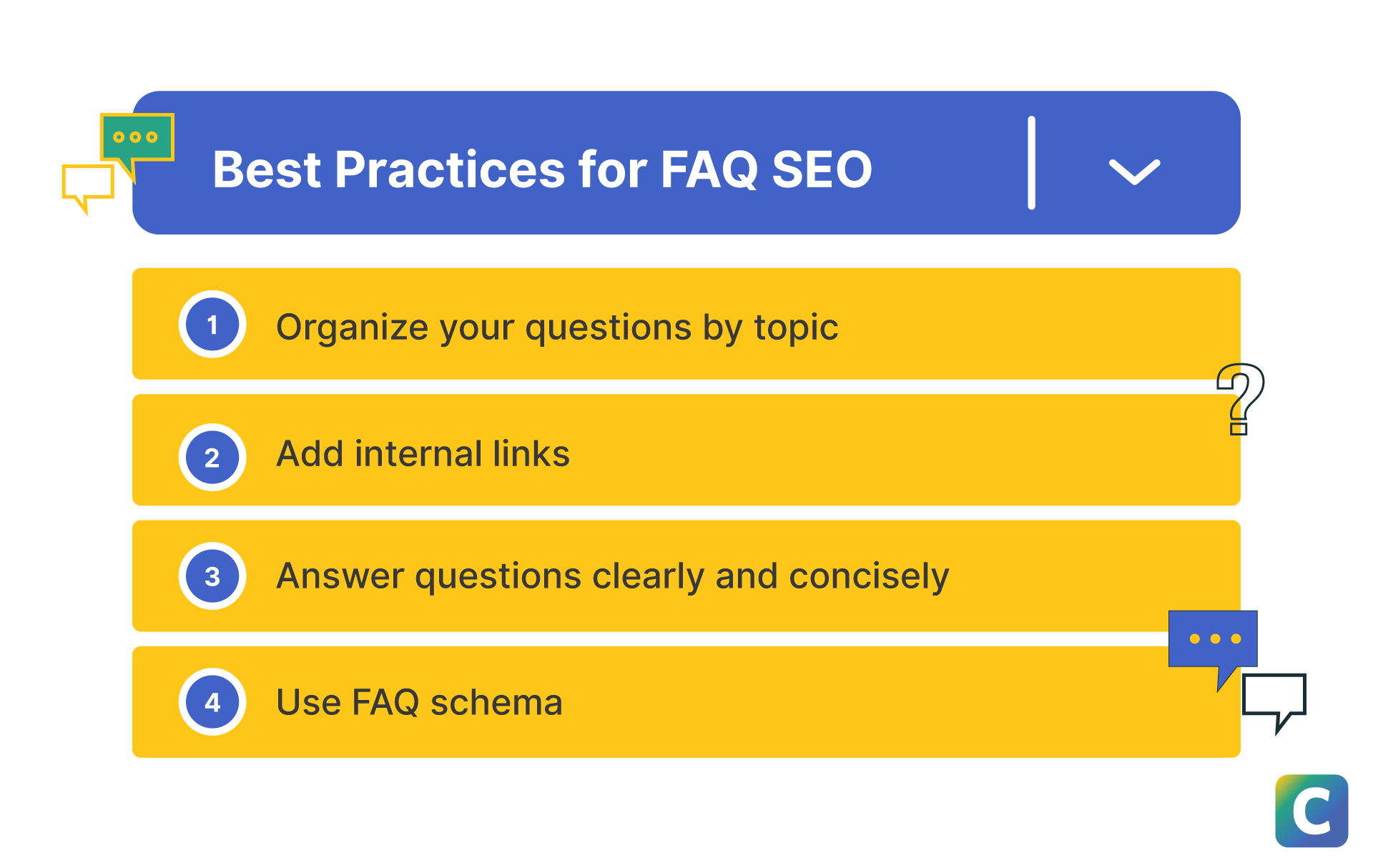
FAQ SEO best practices.
Now that we’ve gone over what to include in your FAQ and how to find questions for the page, let’s go over some FAQ SEO best practices.
Organize questions and keep them short and sweet
If you’re adding an FAQ section to an existing page, include a few relevant questions. Between three to five is a good amount. You don’t need to answer every question in an on-page FAQ, just enough to get visitors to stay on your website and click relevant internal links, especially those that get them started through the sales funnel.
You’ll want to keep your answers short and concise. While it may be tempting to over-explain certain points or offer justification, a short paragraph can sum up most answers.
It’s also a good idea to break down your answers with bullet points or use a list format. This makes it easier for both people and robots to find the information they need — part of a good SEO content optimization strategy.
Follow best practices for organizing questions. Group by subject, with related questions under the same page or category. Don’t use an FAQ as an excuse to stuff in keywords. If you’re answering questions about one product, keep that focus unless there is a very compelling reason to mention another.
Target related keywords
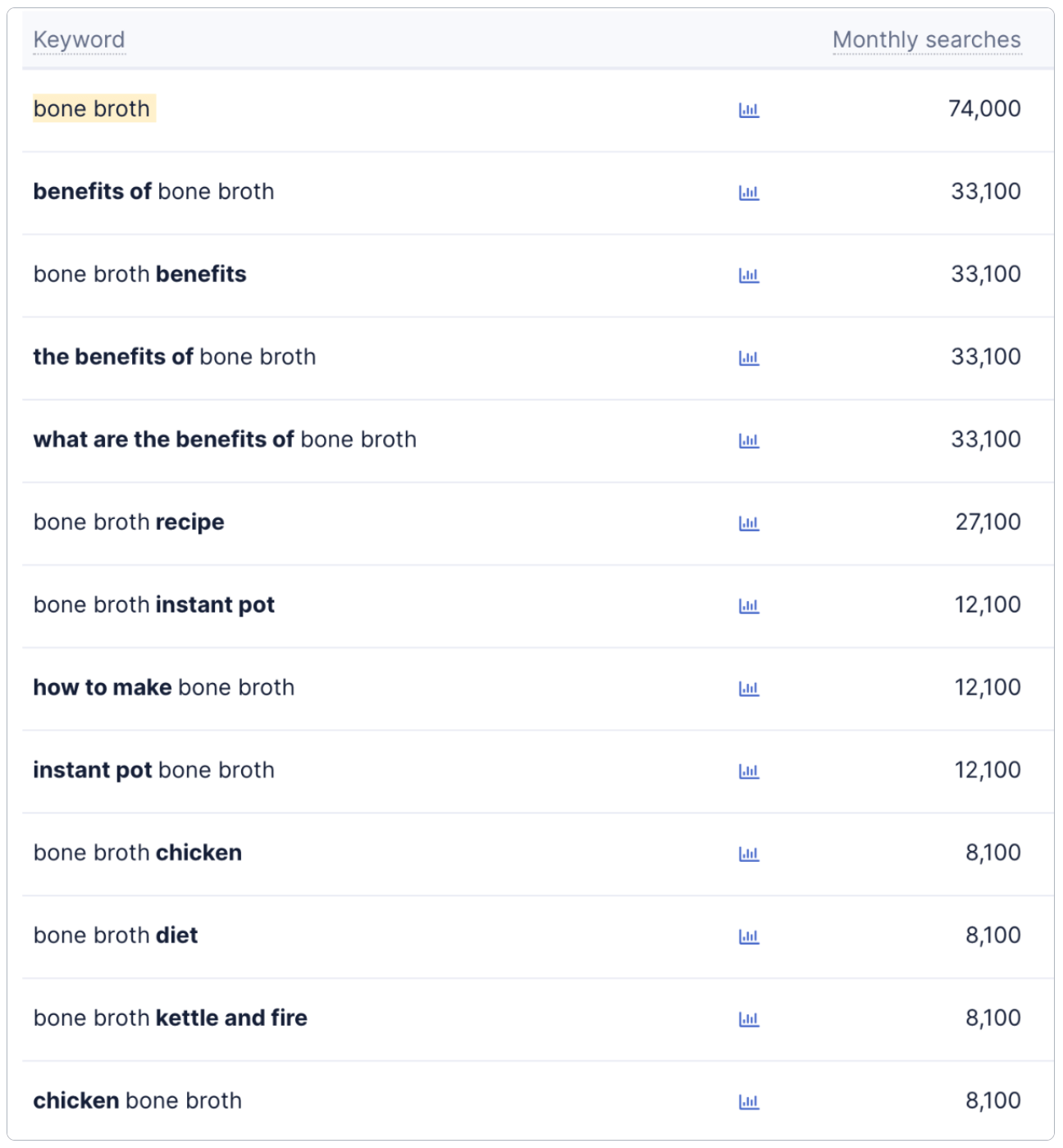
Look for secondary keywords using Clearscope
Part of your keyword research will involve deciding which option is more relevant, has a better search volume, and you could realistically rank for (keyword difficulty). For keywords you aren’t planning to optimize for, a FAQ page is a good opportunity to still use them.
By adding your secondary keywords here, you’ll also boost the chances you could rank for these terms. You might also draw in additional readers with these FAQs if they answer similar questions to those in your main post or use words that are different enough from your main keyword.
In the example above, the user searched for bone broth and found related terms. If you’re writing about a bone broth recipe, you may have chosen that phrase as your specific keyword.
But you could also add an FAQ to the post that covers questions like
“Is bone broth diet-friendly?”
“Can I make Instant Pot bone broth?”
“Is chicken bone broth easy to make?”
By incorporating these secondary terms, you’ll have a better chance of reaching readers who may have otherwise missed your post if their original search was a bit different.
Internal linking is your friend
FAQ pages are a great place to work in your internal linking strategy. You can include short, general answers on the main page, then expand your answers with more detail on dedicated articles about specific topics.
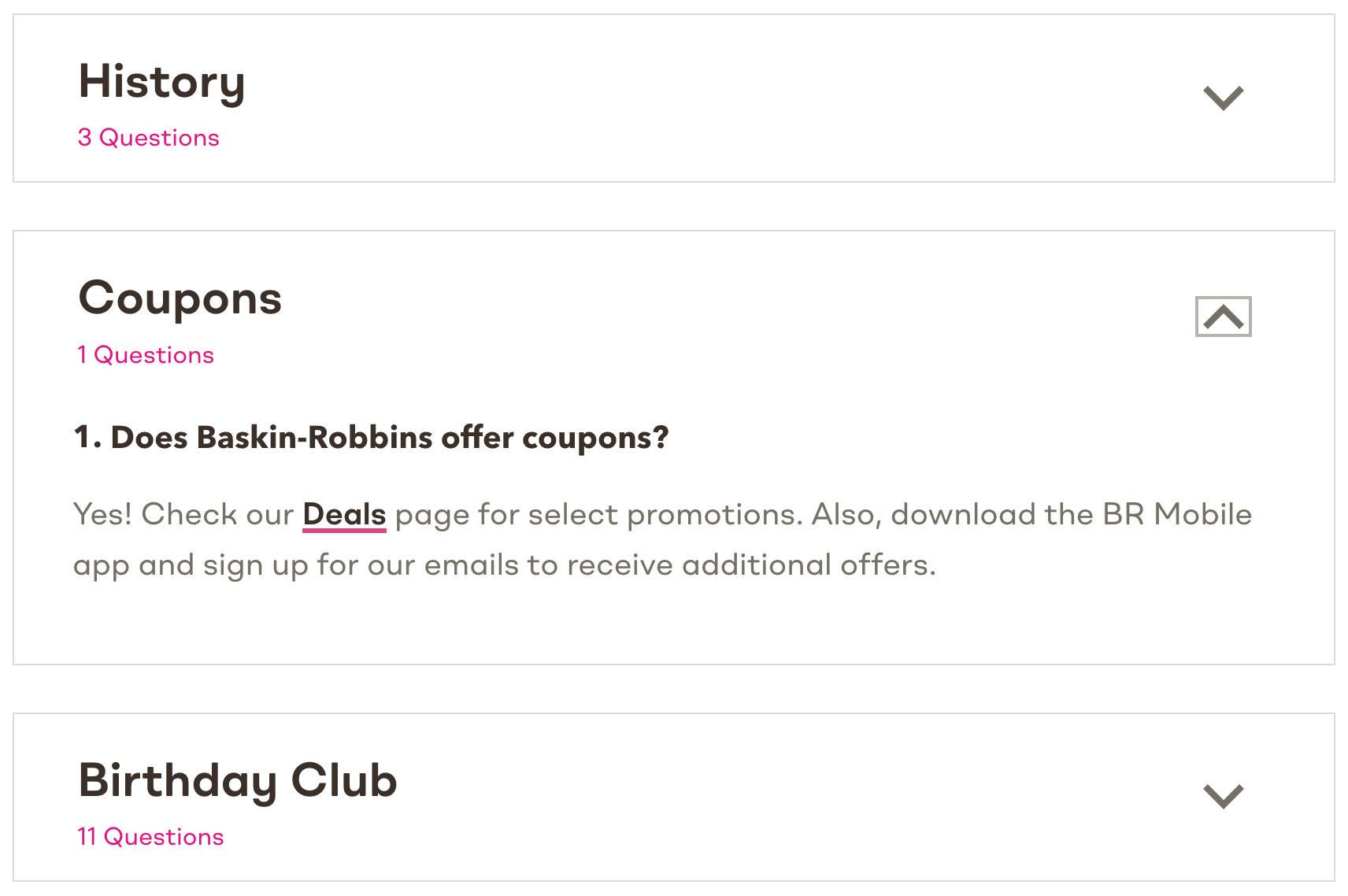
Baskin-Robbins has easy-to-find links on its FAQ page to help redirect customers (image source).
In the example above, Baskin-Robbins makes the use of internal links very clear on its FAQ page. The company not only makes it easy for consumers who are interested in coupons to go to its deals page, but it also has links to its menu and “find a shop” pages.
These links work well because they’re relevant to the question a potential customer might have. Internal links make navigation much easier for visitors, who won’t have to locate these pages on their own.
Once you have your FAQ optimized and ready to publish, you can focus on FAQ schema.
FAQ schema and how to use it

FAQ schema answers questions directly within Google Search.
FAQ schema is additional metadata you provide to Google to help improve your search visibility in relevant organic searches and may improve your click-through rate (CTR), too. This type of structured data includes specific code that search engines read to create a rich snippet of your FAQ page on search results.
You don’t have to be a coder to create FAQ schema, either. You can create it with schema generators, such as Merkle’s Schema Markup Generator. If you use WordPress, you can use plugins to generate schema, such as Schema Pro. Just make sure you specify that you want to make FAQ schema, as there are a few types of snippets to choose from.
By adding FAQ schema to your website, you can designate specific questions to be directly featured on relevant search engine results pages (SERPs). If you have questions that use keywords with high search volume, it may make sense to prioritize those.
Internal links can also pop up in these rich results, so this is yet another reason to include them. You’ll encourage clicks to these pages directly from the snippet.
FAQs about FAQs
This FAQ SEO guide wouldn’t be complete without an FAQ of its own, so here are some frequently asked questions about writing FAQs:
Should I only use one kind of FAQ page?
You can use as many FAQ pages as you like. You want to be sure your answers don’t contradict each other, an important consideration if you’re due for a content refresh.
You might end up repeating some answers if you have both a dedicated FAQ and FAQs on multiple product pages. Be careful not to write exactly the same copy so you don’t unintentionally create duplicate content.
What are some good research tools to use when creating an FAQ page?
We’ve touched on a few tools and resources— here’s a handy recap:
Quora
Reddit
Schema Pro
Clearscope Drafts
Google’s People also ask
Google Ads Keyword Planner
Merkle’s Schema Markup Generator
What if I don’t know how to write the questions for my FAQs?
If you haven’t written an FAQ before, the process can feel intimidating. Ultimately, it’s not too different from writing an article. Think in terms of answering questions from your customers’ perspectives.
You can also include a CTA at the end of your answers, encouraging customers to move to a product page or contact you as their next action.
Where should I place my FAQs?
That depends on whether it’s on a dedicated FAQ page or a section of a webpage.
For dedicated FAQ pages, placing them either directly in your navigational menu or with the customer service page is usually a safe bet.
If you’re wondering where to place the FAQ section on a landing page or product page, that’s a bit different. You may find right above the footer works well, especially if you place a clear CTA in that section. If your product page has a separate description area, placing the FAQ in that area makes sense for searchers, too.
Final thoughts: How FAQ SEO works and how to optimize FAQ pages
FAQs are useful, helpful pages that customers actively use and seek out.
You can use your FAQ page or section to add content your readers are looking for, with clear, concise answers. This is also a great place to add related keywords and build up your internal linking strategy.
Optimizing your FAQ helps relevant visitors find your website and answers to the questions they have, potentially boosting your conversions. It also improves your chances of landing on one of Google’s FAQ snippets.
When you take advantage of some of the tools available, it shouldn’t be too hard to find questions to add to your FAQ. You can use Clearscope Drafts, social media, and Google tools to start.
On-Page SEO: What it is, Why it Matters, & How To Optimize
Here’s what industry experts have to say about on-page SEO. Learn what it is, why it’s important, and how to use it to improve your organic traffic.
Read more11-step checklist for SEO content editing (with guided reports)
Master SEO content editing with this 11-step checklist. Learn how to optimize your content for search engines, improve rankings, and use Clearscope’s AI-powered reports to streamline the editing process.
Read moreWhy Ranch-Style SEO Is Your Future-Proof Content Strategy
Learn what ranch-style SEO is, why it works, and how to use this perspective-driven content strategy to your advantage. Spoiler: It's the future of SEO.
Read more